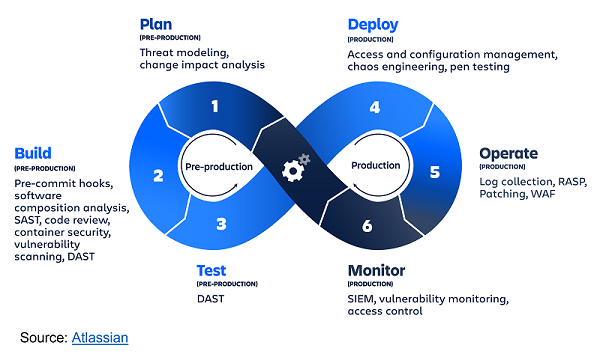Let’s begin with DevOps first.
DevOps is an amalgamation of cultural and technical philosophies of software development, quality assurance, and IT operations united into a single system managed centrally. The overarching purpose of having a DevOps philosophy is to increase the speed at which applications and support services are delivered. At the same time, DevOps emphatically negates the bimodal notion that speed and stability are mutually exclusive and instead reinstates the concept that speed depends upon stability.
To realize the complete advantage of the agility of a DevOps approach, IT security must also play an integrated role in the entire application development life cycle. Therefore, a DevOps framework demands security as a shared integrated responsibility end-to-end. This is where “DevSecOps” comes into the picture to accentuate the need to inculcate a security foundation into DevOps initiatives.
DevSecOps, short for Development, Security and Operations, integrates security at every phase of the SDLC, enabling the development of robust and secure applications at the speed of Agile and DevOps. DevSecOps is about built-in security, not security that functions as a perimeter around apps and data.
In the past, organizations included security features within the developed code towards the end of SDLC and were noted by a separate team. However, with the evolution of SDLC and multiple software releases in a year, it became operationally impossible to follow the old approach. With software developers adopting Agile and DevOps practices, the SDLC now ranges from weeks to days, and the traditional reactive approach to security has become obsolete.
DevSecOps addresses security issues as they arise- at the stage where they are easy to identify and tackle, i.e., before the software gets into the production stage. Thus, DevSecOps makes security a shared responsibility of the development, security, and IT operations teams rather than the sole responsibility of a security team.

According to a report by Grandview Research, the global DevSecOps market size was valued at USD 2.79 billion in 2020 and is expected to expand at a compound annual growth rate (CAGR) of 24.1% from 2021 to 2028. In addition, the continued rise in the number of businesses and applications migrating to the cloud, 5G rollouts, and Internet of Things deployments are also expected to favour the growth of the development, security, and operation (DevSecOps) market.
According to Markets & Markets, APAC is estimated to account for the largest DevSecOps market size during the forecast period.
The APAC region is expected to offer extensive growth opportunities for the market during the forecast period. Rapid advancements in cloud computing, IT infrastructure services, and the Internet of Things (IoT) have led many organizations to adopt DevSecOps solutions and services.
DevSecOps brings cybersecurity processes into the SDLC from the very start. Throughout the development cycle, the software code is reviewed, audited, and tested for security issues that are addressed soon after identification.
Some of the industry-advocated best practices in the DevSecOps are:
‘Shift-Left’ approach encourages software engineers to move security from the right (end) to the left (beginning) of the DevOps (delivery) process. Shifting left allows the team to identify security risks and vulnerabilities early in the SDLC & address them immediately. This helps the development team to build the product efficiently & inculcate security features as they build it.
The philosophy “security is everyone’s responsibility” should be a part of an organization’s culture. An alliance between the development, operations and compliance teams ensures that everyone in the organization understands the company’s security posture and adheres to the same standards.
The leaders within an organization should promote change & allocate security responsibilities and product ownership. When both developers and security teams become process owners and take responsibility for their work, it fosters collaboration and cultural changes towards DevSecOps initiatives.
IBM suggests implementing traceability, audits, and visibility in a DevSecOps process to create a more secure environment:
– Traceability: To track configuration items across the SDLC to locate where requirements are implemented in the code. It helps achieve compliance, track & reduce bugs, ensure secure code in application development, and support code maintainability.
– Auditability: For ensuring technical, procedural, and administrative security controls for compliance. The processes need to be auditable, well-documented and adhered to by all team members.
– Visibility: Visibility ensures that the organization has a robust monitoring system to monitor operations, send alerts, communicate changes, deal with vulnerabilities as they hit, and provide accountability.
The DevSecOps approach brings with it a multitude of benefits. Some of them are:
DevSecOps adoption is on the rise, though still emerging as a best practice for developing secure, high-quality code. As DevSecOps practices pick up, the industry is seeing many parallel and facilitating technology trends which would contribute towards the growth of DevSecOps adoption. From Infrastructure as a Code (IaaC), AIOps & GitOps, Serverless Architecture and Kubernetes infrastructure, these technologies will help organizations innovate faster without sacrificing security and product quality, & enable collaboration between teams, and automate processes that ensure quality control.